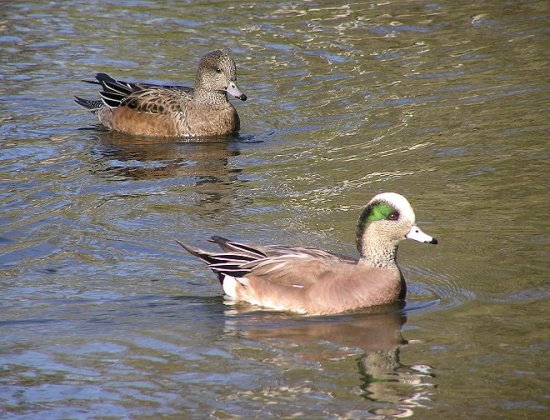(almost everything) |
(genus change (IOC and Clements)) |
||
| Line 1: | Line 1: | ||
[[Image:American_Wigeon.jpg|thumb|550px|right|Photo by {{user|Leslie|Leslie}}]] | [[Image:American_Wigeon.jpg|thumb|550px|right|Photo by {{user|Leslie|Leslie}}]] | ||
| − | ;[[:Category: | + | ;[[:Category:Mareca|Mareca]] americana |
==Identification== | ==Identification== | ||
45-56cm<br /> | 45-56cm<br /> | ||
| Line 16: | Line 16: | ||
This is a monotypic species<sup>[[#References|[1]]]</sup>. The closest relative of this species seems to be [[Chiloe Wigeon]] and not [[Eurasian Wigeon]]<sup>[[#References|[2]]]</sup>. | This is a monotypic species<sup>[[#References|[1]]]</sup>. The closest relative of this species seems to be [[Chiloe Wigeon]] and not [[Eurasian Wigeon]]<sup>[[#References|[2]]]</sup>. | ||
| − | + | Formerly placed in the genus ''[[:Category:Anas|Anas]]''. | |
==Habitat== | ==Habitat== | ||
| Line 29: | Line 29: | ||
The male has a weak clear whistle in three syllables: ''wee-whee-whoe'' (middle is higher pitched), whereas the female has a low growl qua-ack. | The male has a weak clear whistle in three syllables: ''wee-whee-whoe'' (middle is higher pitched), whereas the female has a low growl qua-ack. | ||
==References== | ==References== | ||
| − | #{{Ref- | + | #{{Ref-Clements6thAug17}}#[http://www.museum.lsu.edu/~Remsen/SACCBaseline.html SACC] baseline read October 2009 |
# Beaman, M., S. Madge, K.M. Olsen. 1998. Fuglene i Europa, Nordafrika og Mellemøsten. Copenhagen, Denmark: Gads Forlag, ISBN 87-12-02276-4 | # Beaman, M., S. Madge, K.M. Olsen. 1998. Fuglene i Europa, Nordafrika og Mellemøsten. Copenhagen, Denmark: Gads Forlag, ISBN 87-12-02276-4 | ||
# Mowbray, Thomas. 1999. American Wigeon (Anas americana), [http://bna.birds.cornell.edu.bnaproxy.birds.cornell.edu/bna/species/401 The Birds of North America Online] read October 2009 | # Mowbray, Thomas. 1999. American Wigeon (Anas americana), [http://bna.birds.cornell.edu.bnaproxy.birds.cornell.edu/bna/species/401 The Birds of North America Online] read October 2009 | ||
{{ref}} | {{ref}} | ||
==External Links== | ==External Links== | ||
| − | {{GSearch| | + | {{GSearch|Wigeon+americana}} |
| − | [[Category:Birds]][[Category: | + | [[Category:Birds]][[Category:Mareca]] |
Revision as of 11:46, 26 August 2017

- Mareca americana
Identification
45-56cm
Male in breeding plumage: Body shows pinkish-brown flanks and breast, white belly and body side just in front of the undertail coverts, black undertail coverts. Head and neck is greyish with green eye patch and a whitish crown stripe. Wings have white upper secondary coverts, speculum dark green bordered in black; on underside white axillaries and middle coverts
Male in eclipse plumage mainly like female.
Female: belly white, breast and flanks are light brown (or rust-orange) in contrast to grey neck and head, which mostly shows darker mask around the eye than Eurasian Wigeon. White axillaries and underwing middle coverts as in male; upperside of wing with very dark speculum, brownish-grey secondary coverts that most often are whitish at the rear, rarely just as white as the coverts on a male.
Similar Species
Eurasian Wigeon, Chiloe Wigeon. Eurasian Wigeon has grey axillaries and middle coverts in all plumages (beware of influences of bad light), and less contrast between grey on neck and brownish on body.
Distribution
Alaska south throughout most of Canada and western United States.
Winters to north-west South America
Taxonomy
This is a monotypic species[1]. The closest relative of this species seems to be Chiloe Wigeon and not Eurasian Wigeon[2].
Formerly placed in the genus Anas.
Habitat
Breeds in short-grass and other prairie in the vicinity of shallow wetlands. On migration and winter, forages in marshes, fields, and shallow waters.
Behaviour
A dabbling duck, but more likely to be grazing on fields than most other Anas ducks.
Diet
The diet includes vegetable matter, only females in early breeding will eat large amounts of non-vegetarian food.
Breeding
Seven to ten eggs is most common, with wider variations possible. Eggs are creamy-yellow to white and nest is in grassy/scrubby areas near water.
Vocalisation
The male has a weak clear whistle in three syllables: wee-whee-whoe (middle is higher pitched), whereas the female has a low growl qua-ack.
References
- Clements, J. F., T. S. Schulenberg, M. J. Iliff, D. Roberson, T. A. Fredericks, B. L. Sullivan, and C. L. Wood. 2017. The eBird/Clements checklist of birds of the world: v2017, with updates to August 2017. Downloaded from http://www.birds.cornell.edu/clementschecklist/download/
- SACC baseline read October 2009
- Beaman, M., S. Madge, K.M. Olsen. 1998. Fuglene i Europa, Nordafrika og Mellemøsten. Copenhagen, Denmark: Gads Forlag, ISBN 87-12-02276-4
- Mowbray, Thomas. 1999. American Wigeon (Anas americana), The Birds of North America Online read October 2009
Recommended Citation
- BirdForum Opus contributors. (2024) American Wigeon. In: BirdForum, the forum for wild birds and birding. Retrieved 15 May 2024 from https://www.birdforum.net/opus/American_Wigeon




